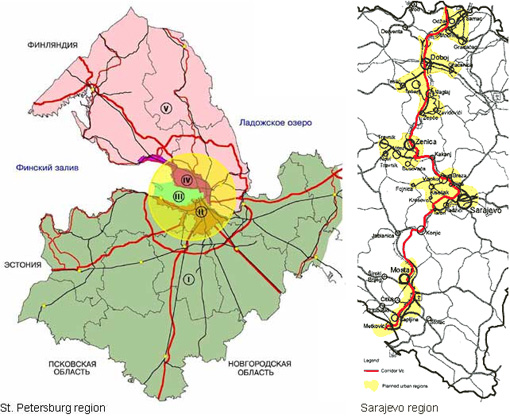client: Swiss National Science Foundation SNF; Swiss Office for Development Co-operation DEZA
team: Güller Güller architecture urbanism, Walter Schenkel Synergo (political scientist)
Regional territorial structures and planning responsibilities in countries in transition such as Bosnia and Herzegovina or Russia are constantly undergoing changes. This is considerably slowing down planning processes and a coordinated development. At the same time, the relative independency of regions is ever more challenged from the outside by European integration and the dynamic of international economic activities.
To fill the vacuum between internal transformations and external challenges, this project is rediscovering forgotten structures of inter-regional co-operation as well as establishing new ones. They are tested and further developed on practical issues of large-scale transport infrastructures and urban development, as these issues are more and more becoming tasks concerning several regions simultaneously.
Sarajevo
With development strategies for city-networks and the possible TEN-highway-corridors in Bosnia and Herzegovina and all of former Yugoslavia, the work in Sarajevo has succeeded in launching a bottom-up process of multi-disciplinary and inter-regional co-operation within Bosnia and Herzegovina as well with the surrounding countries - for the first time in 10 years! The impulse of this project is now taken into a next phase, where ideological boundaries are challenged with concrete strategic planning.
St. Petersburg
The Russian regions being of the scale of Central European countries, the focus of the study in St. Petersburg was on the city's and region's function as a gateway of a major part of Russia (the North-West-macro-region) to Europe, with a special interest in the logistics and network of maritime ports in the Gulf of Finland. Under the prevailing adverse conditions for spatial and strategic planning in Russian regions it seems that development is more likely to happen due to private initiative of international investors than due to public planning strategies.

Inter-regional Co-operation in Eastern Europe
Sarajevo, Bosnia&Herzegovina; St Petersburg, Russia, 2000-2003
SCOPES publication (pdf)
Sarajevo, Bosnia&Herzegovina; St Petersburg, Russia, 2000-2003
SCOPES publication (pdf)
